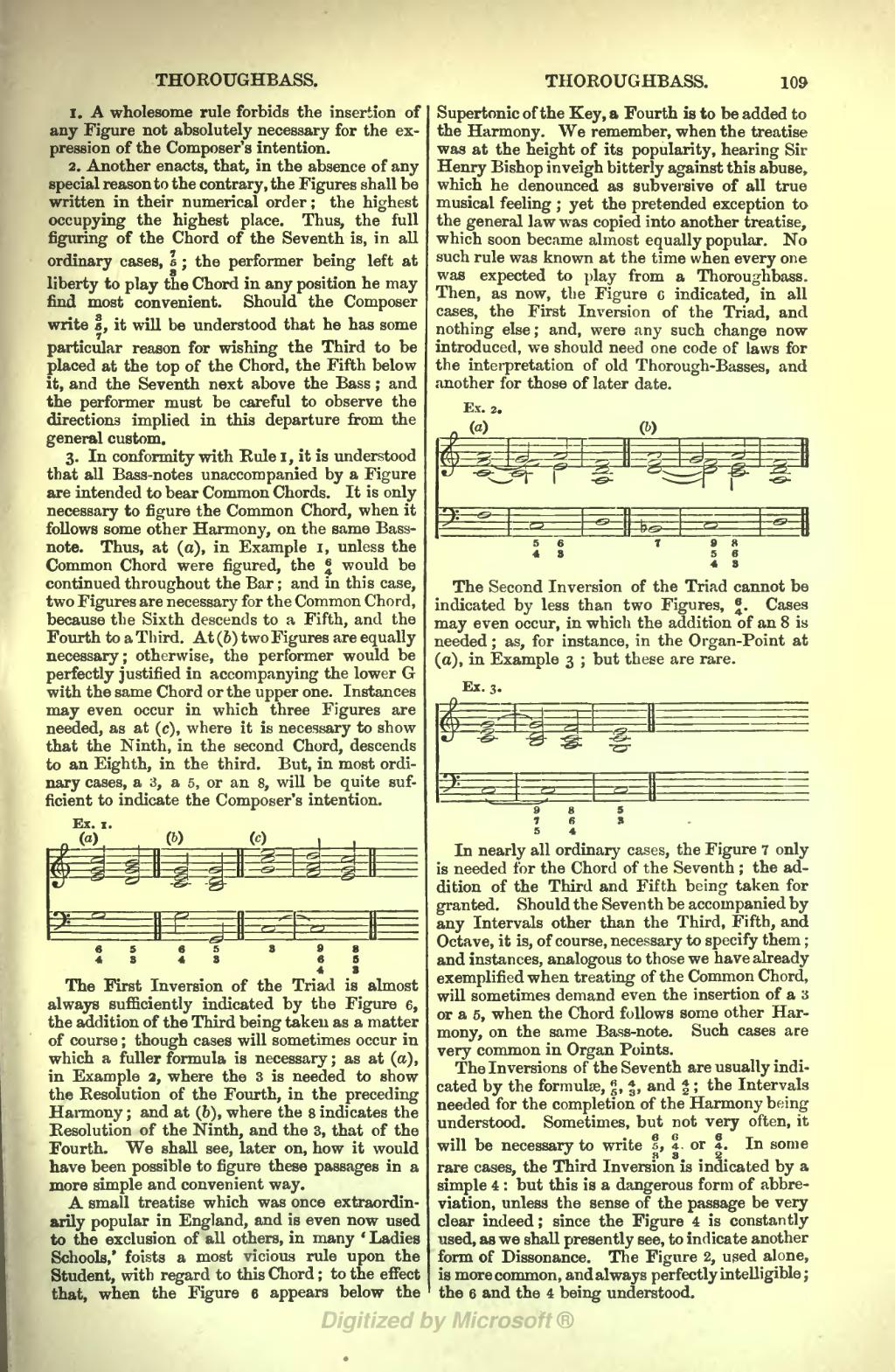1. A wholesome rule forbids the insertion of any Figure not absolutely necessary for the expression of the Composer's intention.
2. Another enacts, that, in the absence of any special reason to the contrary, the Figures shall be written in their numerical order; the highest occupying the highest place. Thus, the full figuring of the Chord of the Seventh is, in all ordinary cases, 753; the performer being left at liberty to play the Chord in any position he may find most convenient. Should the Composer write 357, it will be understood that he has some particular reason for wishing the Third to be placed at the top of the Chord, the Fifth below it, and the Seventh next above the Bass; and the performer must be careful to observe the directions implied in this departure from the general custom.
3. In conformity with Rule 1, it is understood that all Bass-notes unaccompanied by a Figure are intended to bear Common Chords. It is only necessary to figure the Common Chord, when it follows some other Harmony, on the same Bassnote. Thus, at (a), in Example 1, unless the Common Chord were figured, the 64 would be continued throughout the Bar; and in this case, two Figures are necessary for the Common Chord, because the Sixth descends to a Fifth, and the Fourth to a Third. At (b) two Figures are equally necessary; otherwise, the performer would be perfectly justified in accompanying the lower G with the same Chord or the upper one. Instances may even occur in which three Figures are needed, as at (c), where it is necessary to show that the Ninth, in the second Chord, descends to an Eighth, in the third. But, in most ordinary cases, a 3, a 5, or an 8, will be quite sufficient to indicate the Composer's intention.

The First Inversion of the Triad is almost always sufficiently indicated by the Figure 6, the addition of the Third being taken as a matter of course; though cases will sometimes occur in which a fuller formula is necessary; as at (a), in Example 2, where the 3 is needed to show the Resolution of the Fourth, in the preceding Harmony; and at (b), where the 8 indicates the Resolution of the Ninth, and the 3, that of the Fourth. We shall see, later on, how it would have been possible to figure these passages in a more simple and convenient way.
A small treatise which was once extraordinarily popular in England, and is even now used to the exclusion of all others, in many 'Ladies Schools,' foists a most vicious rule upon the Student, with regard to this Chord; to the effect that, when the Figure 6 appears below the Supertonic of the Key, a Fourth is to be added to the Harmony. We remember, when the treatise was at the height of its popularity, hearing Sir Henry Bishop inveigh bitterly against this abuse, which he denounced as subversive of all true musical feeling; yet the pretended exception to the general law was copied into another treatise, which soon became almost equally popular. No such rule was known at the time when every one was expected to play from a Thoroughbass. Then, as now, the Figure 6 indicated, in all cases, the First Inversion of the Triad, and nothing else; and, were any such change now introduced, we should need one code of laws for the interpretation of old Thorough-Basses, and another for those of later date.

The Second Inversion of the Triad cannot be indicated by less than two Figures, 64. Cases may even occur, in which the addition of an 8 is needed; as, for instance, in the Organ-Point at (a), in Example 3; but these are rare.

In nearly all ordinary cases, the Figure 7 only is needed for the Chord of the Seventh; the addition of the Third and Fifth being taken for granted. Should the Seventh be accompanied by any Intervals other than the Third, Fifth, and Octave, it is, of course, necessary to specify them; and instances, analogous to those we have already exemplified when treating of the Common Chord, will sometimes demand even the insertion of a 3 or a 5, when the Chord follows some other Harmony, on the same Bass-note. Such cases are very common in Organ Points.
The Inversions of the Seventh are usually indicated by the formulæ, 65, 43 and 42; the Intervals needed for the completion of the Harmony being understood. Sometimes, but not very often, it will be necessary to write 653, 643 or 642. In some rare cases, the Third Inversion is indicated by a simple 4: but this is a dangerous form of abbreviation, unless the sense of the passage be very clear indeed; since the Figure 4 is constantly used, as we shall presently see, to indicate another form of Dissonance. The Figure 2, used alone, is more common, and always perfectly intelligible; the 6 and the 4 being understood.
